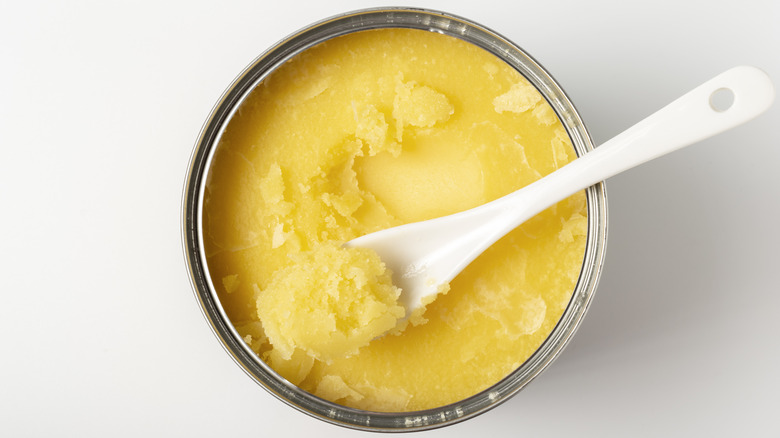Canned Butter Is Apparently A Thing
You've probably passed by the dehydrated foods aisle at the local grocery or camping store before. It's usually full of just-add-water premade meals such as spaghetti and meatballs or oatmeal and raisins. But seeing a tub of powdered butter may catch you by surprise. And while it may seem wild at first, powdered butter actually isn't that different from the regular stuff — it's simply butter that has had its moisture removed before being ground into a fine powder.
Powdered butter is typically sold in air-tight cans, and is a solid choice for emergency food supplies. And Americans have been using it for a long time — just look at this TikTokkers taste test of powdered butter from the 1960s. They spit out a mouthful of the stuff, shouting, "That's chemicals! I don't know what that is." However, powdered butter typically only includes a few ingredients: butter, nonfat milk, and a preservative or two. It can be used in baked goods or sprinkled on top of foods for a flaky but rich topping. If the powdery texture of this canned butter throws you off, there are some other choices on the market that more closely resemble the stuff you usually buy at home.
Can I make my own at home?
@wafffler69
These days, shelf-stable canned butter is really just pasteurized cream and salt, and can actually make for a pretty gourmet product, like Red Feather Canned Butter, which shakes out to be about a price of $9 per can. And while the canned factor might be a bit questionable, Red Feather says that customers find their product to be "indiscernible from fresh butter after more than a decade of room-temperature storage."
Whether you're looking to reduce food waste, experiment with dehydrated dairies in cooking or baking, or stock up in case of emergency, canned butter might actually not be such a bad idea. It should be noted even brands like Red Feather technically expire after a few years, though it's likely they retain flavor and nutrition after that date. If long-term storage is the goal, and flavor and texture aren't your top priority, you may be best off with dehydrated, powdered canned butter.
Other ways to preserve butter
You may be thinking to yourself that you've got cans, jars, and butter — what's stopping you from making your own canned butter and saving a fortune? But resist that impulse. In a statement to All Recipes, Master Food Preserver Anne Kuo said in no uncertain terms, "Per USDA and research, there's no safe way to can butter or any dairy at home." That's because canned dairy is a magnet for botulism, a classification of dangerous spores that grow in low-oxygen environments, like canned foods. Instead, it's best to buy canned butter from a mass-manufactured company.
However, shelf-stable butter goes far beyond Westernized versions. Ghee, or clarified butter, is a great long-term, pantry-safe choice, and its origins extend all the way back to ancient India. The hot climate of India meant that dairy would go bad before it could be used. Ghee was the result of a preservation method that also happens to produce a gorgeous, flavorful, golden spread, and it is still used regularly in modern Indian cooking. It is essentially butter that has been cooked down to remove its water and milk solids. Without the milk solids, the clarified butter is not at risk for botulism the same way other dairy products are. So if you're looking for a more budget-friendly or easy-to-make butter alternative, ghee could be the ticket.

